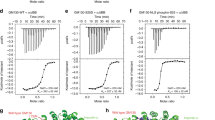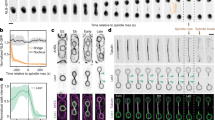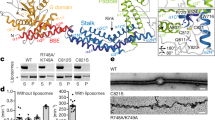Abstract
The Golgi apparatus undergoes extensive disassembly during mitosis and reassembly in post-mitotic daughter cells. This process has been mimicked in vitro by treating Golgi membranes with mitotic and interphase cytosol. To determine the minimal machinery that controls the morphological change, we have developed a defined Golgi disassembly and reassembly assay that reconstitutes this process using purified proteins instead of cytosol. Treatment of Golgi membranes with mitotic kinases and COPI coat proteins efficiently disassembles the membranes into mitotic Golgi fragments, whereas further incubation with p97 or N-ethylmaleimide-sensitive factor (two AAA ATPases involved in membrane fusion) and their cofactors, in combination with protein phosphatase PP2A, leads to reassembly of the membranes into new Golgi stacks. The whole process takes 3–4 d and is applicable for identification and determination of novel cytosolic and membrane proteins that regulate Golgi membrane dynamics in the cell cycle.
This is a preview of subscription content, access via your institution
Access options
Subscribe to this journal
Receive 12 print issues and online access
$259.00 per year
only $21.58 per issue
Buy this article
- Purchase on Springer Link
- Instant access to full article PDF
Prices may be subject to local taxes which are calculated during checkout



Similar content being viewed by others
References
Acharya, U. et al. The formation of Golgi stacks from vesiculated Golgi membranes requires two distinct fusion events. Cell 82, 895–904 (1995).
Jamora, C. et al. Regulation of Golgi structure through heterotrimeric G proteins. Cell 91, 617–626 (1997).
Kano, F., Nagayama, K. & Murata, M. Reconstitution of the Golgi reassembly process in semi-intact MDCK cells. Biophys. Chem. 84, 261–268 (2000).
Kano, F. et al. MEK and Cdc2 kinase are sequentially required for Golgi disassembly in MDCK cells by the mitotic Xenopus extracts. J. Cell. Biol. 149, 357–368 (2000).
Misteli, T. & Warren, G. COP-coated vesicles are involved in the mitotic fragmentation of Golgi stacks in a cell-free system. J. Cell. Biol. 125, 269–282 (1994).
Rabouille, C., Misteli, T., Watson, R. & Warren, G. Reassembly of Golgi stacks from mitotic Golgi fragments in a cell-free system. J. Cell. Biol. 129, 605–618 (1995).
Shorter, J. & Warren, G. Golgi architecture and inheritance. Annu. Rev. Cell. Dev. Biol. 18, 379–420 (2002).
Wang, Y. Golgi apparatus inheritance. In The Golgi Apparatus. State of the Art 110 Years After Camillo Golgi's Discovery, Vol. Chapter 4.3. (eds. Mironov, A., Pavelka, M. & Luini, A.) 580–607 (Springer-Verlag Gmbh., Wien-New York, 2008).
Barr, F.A., Puype, M., Vandekerckhove, J. & Warren, G. GRASP65, a protein involved in the stacking of Golgi cisternae. Cell 91, 253–262 (1997).
Wang, Y., Seemann, J., Pypaert, M., Shorter, J. & Warren, G. A direct role for GRASP65 as a mitotically regulated Golgi stacking factor. EMBO J. 22, 3279–3290 (2003).
Shorter, J. et al. GRASP55, a second mammalian GRASP protein involved in the stacking of Golgi cisternae in a cell-free system. EMBO J. 18, 4949–4960 (1999).
Lowe, M. et al. Cdc2 kinase directly phosphorylates the cis-Golgi matrix protein GM130 and is required for Golgi fragmentation in mitosis. Cell 94, 783–793 (1998).
Sonnichsen, B. et al. A role for giantin in docking COPI vesicles to Golgi membranes. J. Cell. Biol. 140, 1013–1021 (1998).
Satoh, A., Wang, Y., Malsam, J., Beard, M.B. & Warren, G. Golgin-84 is a rab1 binding partner involved in Golgi structure. Traffic 4, 153–161 (2003).
Shorter, J. & Warren, G. A role for the vesicle tethering protein, p115, in the post-mitotic stacking of reassembling golgi cisternae in a cell-free system. J. Cell. Biol. 146, 57–70 (1999).
Rabouille, C. et al. Syntaxin 5 is a common component of the NSF- and p97-mediated reassembly pathways of Golgi cisternae from mitotic Golgi fragments in vitro . Cell 92, 603–610 (1998).
Rabouille, C., Levine, T.P., Peters, J.M. & Warren, G. An NSF-like ATPase, p97, and NSF mediate cisternal regrowth from mitotic Golgi fragments. Cell 82, 905–914 (1995).
Kondo, H. et al. p47 is a cofactor for p97-mediated membrane fusion. Nature 388, 75–78 (1997).
Meyer, H.H., Wang, Y. & Warren, G. Direct binding of ubiquitin conjugates by the mammalian p97 adaptor complexes, p47 and Ufd1-Npl4. EMBO J. 21, 5645–5652 (2002).
Wang, Y., Satoh, A., Warren, G. & Meyer, H.H. VCIP135 acts as a deubiquitinating enzyme during p97-p47-mediated reassembly of mitotic Golgi fragments. J. Cell. Biol. 164, 973–978 (2004).
Tang, D., Mar, K., Warren, G. & Wang, Y. Molecular mechanism of mitotic Golgi disassembly and reassembly revealed by a defined reconstitution assay. J. Biol. Chem. 283, 6085–6094 (2008).
Lin, C.Y. et al. Peripheral Golgi protein GRASP65 is a target of mitotic polo-like kinase (Plk) and Cdc2. Proc. Natl. Acad. Sci. USA 97, 12589–12594 (2000).
Wang, Y., Satoh, A. & Warren, G. Mapping the functional domains of the Golgi stacking factor GRASP65. J. Biol. Chem. 280, 4921–4928 (2005).
Xiang, Y., Seemann, J., Bisel, B., Punthambaker, S. & Wang, Y. Active ADP-ribosylation factor-1 (ARF1) is required for mitotic Golgi fragmentation. J. Biol. Chem. 282, 21829–21837 (2007).
Otter-Nilsson, M., Hendriks, R., Pecheur-Huet, E.I., Hoekstra, D. & Nilsson, T. Cytosolic ATPases, p97 and NSF, are sufficient to mediate rapid membrane fusion. EMBO J. 18, 2074–2083 (1999).
Muller, J.M. et al. An NSF function distinct from ATPase-dependent SNARE disassembly is essential for Golgi membrane fusion. Nat. Cell. Biol. 1, 335–340 (1999).
Muller, J.M. et al. Sequential SNARE disassembly and GATE-16-GOS-28 complex assembly mediated by distinct NSF activities drives Golgi membrane fusion. J. Cell. Biol. 157, 1161–1173 (2002).
Uchiyama, K. et al. p37 is a p97 adaptor required for Golgi and ER biogenesis in interphase and at the end of mitosis. Dev. Cell. 11, 803–816 (2006).
Hui, N., Nakamura, N., Slusarewicz, P. & Warren, G. Purification of rat liver Golgi stacks. In Cell Biology: A Laboratory Handbook, Vol. 2 (ed. Celis, J.) 46–55 (Academic Press, San Diego, California, 1998).
Wang, Y., Taguchi, T. & Warren, G. Purification of rat liver Golgi stacks. In Cell Biology: A Laboratory Handbook, 3rd edn. (ed. Celis, J.) 33–39 (Elsevier Science, San Diego, California, 2006).
Pavel, J., Harter, C. & Wieland, F.T. Reversible dissociation of coatomer: functional characterization of a beta/delta-coat protein subcomplex. Proc. Natl. Acad. Sci. USA 95, 2140–2145 (1998).
Randazzo, P.A., Weiss, O. & Kahn, R.A. Preparation of recombinant ADP-ribosylation factor. Methods Enzymol. 257, 128–135 (1995).
Ha, V.L., Thomas, G.M., Stauffer, S. & Randazzo, P.A. Preparation of myristoylated Arf1 and Arf6. Methods Enzymol. 404, 164–174 (2005).
Whiteheart, S.W. et al. N-ethylmaleimide-sensitive fusion protein: a trimeric ATPase whose hydrolysis of ATP is required for membrane fusion. J. Cell. Biol. 126, 945–954 (1994).
Levine, T.P., Rabouille, C., Kieckbusch, R.H. & Warren, G. Binding of the vesicle docking protein p115 to Golgi membranes is inhibited under mitotic conditions. J. Biol. Chem. 271, 17304–17311 (1996).
Satoh, A., Beard, M. & Warren, G. Preparation and characterization of recombinant golgin tethers. Methods Enzymol. 404, 279–296 (2005).
Beard, M., Satoh, A., Shorter, J. & Warren, G. A cryptic Rab1-binding site in the p115 tethering protein. J. Biol. Chem. 280, 25840–25848 (2005).
Molloy, S.S., Thomas, L., Kamibayashi, C., Mumby, M.C. & Thomas, G. Regulation of endosome sorting by a specific PP2A isoform. J. Cell. Biol. 142, 1399–1411 (1998).
Lucocq, J.M., Berger, E.G. & Warren, G. Mitotic Golgi fragments in HeLa cells and their role in the reassembly pathway. J. Cell. Biol. 109, 463–474 (1989).
Bisel, B. et al. ERK regulates Golgi and centrosome orientation towards the leading edge through GRASP65. J. Cell. Biol. 182, 837–843 (2008).
Xiang, Y. & Wang, Y. GRASP55 and GRASP65 play complementary and essential roles in Golgi cisternal stacking. J. Cell. Biol. 188, 237–251 (2010).
Shima, D.T., Haldar, K., Pepperkok, R., Watson, R. & Warren, G. Partitioning of the Golgi apparatus during mitosis in living HeLa cells. J. Cell. Biol. 137, 1211–1228 (1997).
Altan-Bonnet, N. et al. Golgi inheritance in mammalian cells is mediated through endoplasmic reticulum export activities. Mol. Biol. Cell. 17, 990–1005 (2006).
Malsam, J., Satoh, A., Pelletier, L. & Warren, G. Golgin tethers define subpopulations of COPI vesicles. Science 307, 1095–1098 (2005).
Nickel, W. et al. Uptake by COPI-coated vesicles of both anterograde and retrograde cargo is inhibited by GTPgammaS in vitro . J. Cell. Sci. 111 (Part 20): 3081–3090 (1998).
Serafini, T. & Rothman, J.E. Purification of Golgi cisternae-derived non-clathrin-coated vesicles. Methods Enzymol. 219, 286–299 (1992).
Vielemeyer, O. et al. Direct selection of monoclonal phosphospecific antibodies without prior phosphoamino acid mapping. J. Biol. Chem. 284, 20791–20795 (2009).
Satoh, A., Malsam, J. & Warren, G. Tethering assays for COPI vesicles mediated by golgins. Methods Enzymol. 404, 125–134 (2005).
Meyer, H.H., Kondo, H. & Warren, G. The p47 co-factor regulates the ATPase activity of the membrane fusion protein, p97. FEBS Lett. 437, 255–257 (1998).
Meyer, H.H., Shorter, J.G., Seemann, J., Pappin, D. & Warren, G. A complex of mammalian ufd1 and npl4 links the AAA-ATPase, p97, to ubiquitin and nuclear transport pathways. EMBO J. 19, 2181–2192 (2000).
Acknowledgements
The current Golgi disassembly and reassembly assay was modified from a protocol developed by T. Misteli and C. Rabouille who used purified Golgi membranes, mitotic HeLa cell cytosol and rat liver cytosol5,6. We thank J. Shorter and G. Warren for help and suggestions during our work, M. Jackman, K. Mar, J. Malsam, H. Meyer and T. Taguchi for protein preparations and J. Rothman and G. Thomas for reagents. This work was supported by the Pardee Cancer Research Foundation, the National Institute of Health (GM087364), the American Cancer Society (RGS-09-278-01-CSM), a University of Michigan Rackham Faculty Research Grant, the NIH-funded Michigan Alzheimer's Disease Research Center (P50 AG08761) and an anonymous donation to Y.W.
Author information
Authors and Affiliations
Contributions
Y.W. and Y.X. prepared Golgi membranes, Y.W. performed the Golgi disassembly and reassembly assay and Y.W. and D.T. analyzed the results. Y.W., D.T. and Y.X. wrote the paper.
Corresponding author
Rights and permissions
About this article
Cite this article
Tang, D., Xiang, Y. & Wang, Y. Reconstitution of the cell cycle-regulated Golgi disassembly and reassembly in a cell-free system. Nat Protoc 5, 758–772 (2010). https://doi.org/10.1038/nprot.2010.38
Published:
Issue Date:
DOI: https://doi.org/10.1038/nprot.2010.38
This article is cited by
-
GCAF(TMEM251) regulates lysosome biogenesis by activating the mannose-6-phosphate pathway
Nature Communications (2022)
-
The catalytic subunit of DNA polymerase δ inhibits γTuRC activity and regulates Golgi-derived microtubules
Nature Communications (2017)
-
The ubiquitin ligase HACE1 regulates Golgi membrane dynamics during the cell cycle
Nature Communications (2011)
Comments
By submitting a comment you agree to abide by our Terms and Community Guidelines. If you find something abusive or that does not comply with our terms or guidelines please flag it as inappropriate.



